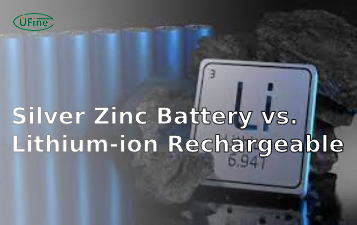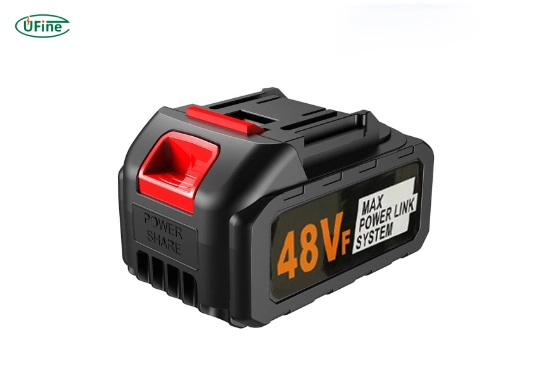
- Part 1. What is a power tool battery?
- Part 2. What does battery voltage mean?
- Part 3. How are 48V and 36V batteries different?
- Part 4. Which tools use 36V batteries?
- Part 5. Which tools use 48V batteries?
- Part 6. Is a 48V battery always better than a 36V?
- Part 7. How long do 48V and 36V batteries last?
- Part 8. Are 48V batteries compatible with 36V tools?
- Part 9. Pros and cons of 48V vs 36V batteries
- Part 10. Who should choose a 48V battery?
- Part 10. FAQs about 48V battery and 36V battery
- Part 11. Summary
When comparing a 48V battery to a 36V battery for power tools, which is better for performance, runtime, and efficiency? The quick answer: 48V batteries are more powerful and offer longer runtime, making them ideal for professionals and heavy workloads. In contrast, 36V batteries are lighter and cost-effective, suitable for general-purpose users.
This comprehensive guide will help you understand the key differences, real-world performance, and which battery type is best for your needs.
Part 1. What is a power tool battery?
A power tool battery is the energy source for cordless tools like drills, saws, and blowers. It stores electrical energy and powers the motor, replacing the need for a direct wall outlet.
Most modern batteries are lithium-ion, known for their:
- High energy density
- Rechargeability
- Long cycle life
- Lightweight design
The voltage of a battery—such as 36V or 48V—determines how much power it can deliver. The higher the voltage, the more powerful the tool.
Part 2. What does battery voltage mean?
Voltage is the measurement of electrical potential. In power tools, higher voltage equals more torque, which translates into:
- Faster cutting
- Deeper drilling
- Easier performance on tough materials
For example:
- A 36V battery can efficiently power a chainsaw to cut through tree branches and small logs.
- A 48V battery can handle larger trees, dense hardwood, or continuous use without losing performance.
In simple terms, voltage is like horsepower in a car—more voltage means more muscle.
Part 3. How are 48V and 36V batteries different?
The main differences between a 48V battery and a 36V battery are power output, runtime, weight, and tool compatibility.
Let’s break it down:
- Power Output: 48V batteries can deliver more watts, leading to higher torque and faster operation.
- Runtime: A 48V battery generally has more capacity, giving you more working time between charges.
- Weight: 48V batteries are heavier, which can affect comfort during prolonged usage.
- Tool Compatibility: 36V batteries are more widely supported; not all brands offer 48V systems.
Below is a comparison table using realistic tool data from leading brands like DeWalt, Makita, and Greenworks:
| Feature | 36V Battery Example (Makita XCU04PT) | 48V Battery Example (Greenworks Pro 60V*) |
|---|---|---|
| Battery Voltage | 36 volts | 48 volts (actual 60V max, 48V nominal) |
| Battery Capacity | 5.0 Ah | 6.0 Ah |
| Total Energy (Wh) | 180 Wh | 288 Wh |
| Chainsaw Cut Capacity | ~150 cuts (6-in log) | ~250 cuts (6-in log) |
| Weight of Battery | 1.5 kg (3.3 lbs) | 2.2 kg (4.8 lbs) |
| Charging Time | ~45 minutes | ~60 minutes |
| Tool Compatibility | Wide (Makita, Bosch, DeWalt) | Limited (Greenworks, Ego) |
| Typical Use Case | Medium-duty yard work, DIY projects | Heavy-duty cutting, pro landscaping |
*Note: Some brands market 60V batteries that operate at 48V nominal voltage under load.
This comparison shows that 48V batteries deliver more energy, which is excellent for demanding tasks. But they are heavier and less common.
Part 4. Which tools use 36V batteries?
Many high-performance tools run on 36V platforms, especially those designed for home and professional use. Common tools include:
- Rotary hammers – Ideal for drilling into concrete and masonry
- Cordless lawn mowers – Efficient for medium-sized yards
- Circular saws – Provide smooth and precise cuts in wood
- Leaf blowers – Great for moderate yard maintenance
- Chainsaws – Suitable for pruning and cutting small trees
Top brands offering 36V tools include:
- Makita
- Bosch
- DeWalt (using 2x 18V batteries)
- HiKOKI/Metabo HPT
These batteries are versatile, lightweight, and widely compatible.
Part 5. Which tools use 48V batteries?
48V batteries are most commonly found in heavy-duty outdoor power equipment. These tools are built for strength, endurance, and professional use:
- Self-propelled lawn mowers – Ideal for large yards or commercial landscaping
- High-output chainsaws – Cut through thick logs with ease
- Backpack blowers – Deliver high airspeed for clearing debris
- Power cutters – Used in construction for cutting concrete or metal
Brands like Greenworks, EGO, and Snapper XD lead in 48V and 60V (nominal 48V) platforms.
These tools are rugged, high-capacity, and ideal for contractors and pros.
Artikel Terkait: How to Choose the Right 48V Battery for Your E‑Bike?
Part 6. Is a 48V battery always better than a 36V?
Not necessarily. A 48V battery provides more power, but it comes with trade-offs.
| Advantage of 48V | Limitation of 48V |
|---|---|
| More torque and cutting power | Heavier and bulkier |
| Longer runtime for demanding tasks | More expensive |
| Ideal for commercial and professional use | Fewer tools are compatible |
If you’re working on high-demand tasks — like cutting hardwood or mowing large areas — then 48V is the better choice. But for everyday users, a 36V battery offers a better weight, price, and performance balance.
Part 7. How long do 48V and 36V batteries last?
Battery lifespan has two meanings:
- Runtime per charge
- Total life in years or charge cycles
Runtime per charge:
- 36V 5.0Ah battery: ~45–60 minutes for medium tasks
- 48V 6.0Ah battery: ~60–90 minutes for heavy-duty tasks
Overall lifespan:
- With proper care, both can last 3–5 years
- Lithium-ion batteries typically support 500–1000 charge cycles
Tips to extend battery life:
- Store in a cool, dry place
- Avoid full discharges
- Use the correct charger
- Don’t leave on the charger overnight
Part 8. Are 48V batteries compatible with 36V tools?
No, they are not interchangeable.
Each tool is built to handle a specific voltage. Using the wrong battery can:
- Damage the circuitry
- Void the warranty
- Pose safety risks
Always use batteries recommended by the tool manufacturer.
Part 9. Pros and cons of 48V vs 36V batteries
36V Battery Pros
- Lighter and easier to handle
- Compatible with many tools
- Widely available
- More affordable
36V Battery Cons
- Less torque and runtime
- May struggle with heavy workloads
48V Battery Pros
- High power and torque
- Longer runtime
- Ideal for industrial or pro use
48V Battery Cons
- Heavier and bulkier
- Costlier
- Limited ecosystem
Part 10. Who should choose a 48V battery?
A 48V battery is best for:
- Landscapers
- Contractors
- Heavy-duty users
- People using tools for hours at a time
If you work with tough materials or large properties, the power and endurance of a 48V system will save you time and effort.
But suppose you’re a homeowner, hobbyist, or occasional DIYer. In that case, a 36V battery is usually more than enough — and easier on your arms and wallet.
Part 10. FAQs about 48V battery and 36V battery
Can I use a 48V battery on a 36V power tool?
No, they are not compatible. Voltage mismatch can harm the tool and battery.
Do 48V batteries last longer than 36V?
Yes, in terms of runtime per charge, 48V batteries generally last longer because they have more energy storage (watt-hours).
Are 48V tools heavier than 36V tools?
Yes. 48V tools and batteries are heavier, which can cause fatigue during extended use.
Is it worth upgrading from 36V to 48V?
If you do heavy work daily, the upgrade is worth it. If you only use tools occasionally, stick with 36V.
What’s the best battery voltage for cordless tools?
For most users, 36V is the sweet spot between power and portability. Choose 48V if your jobs demand maximum performance.
Part 11. Summary
Choosing between a 48V battery and 36V battery depends on your specific needs. If you need raw power, longer runtime, and professional-grade performance, go with a 48V system. But if you prefer a lighter, more affordable, and widely compatible setup, a 36V battery is the better choice.
Both have strengths. The key is matching the battery to your work style. Whether trimming trees, building decks, or landscaping a yard, the correct battery will make your job faster and easier.
Related Tags:
More Articles

What is the Difference Between Silver Zinc Battery vs. Lithium-ion Rechargeable?
Compare silver zinc and lithium-ion rechargeable batteries: energy density, cycle life, safety, cost, and uses in drones, medical devices, EVs, and electronics.
What are Watts and Watt Hours in Battery?
Understand watt vs watt-hour in batteries: key differences, how to calculate capacity, and why they matter. Includes free comparison table.
Best 10 Blood Pressure Monitor Battery Review: Finding the Most Reliable
Are you looking for a reliable Blood Pressure Monitor battery? Here is a complete guide with the top 10 best blood pressure monitor batteries.
Bluetooth Headphone Battery Guide: All You Need to Know
Maximize headphone battery life with expert tips! Learn how to charge, check, troubleshoot, and choose the best bluetooth headphone battery in 2025.
LiFePO4 Battery VS. Lithium-ion Polymer Battery: Which One Is Best?
Comprehensive comparison of LiFePO4 vs Lithium Ion Polymer batteries: energy density, safety, lifespan, cost. Find out which battery suits your needs in 2025.




